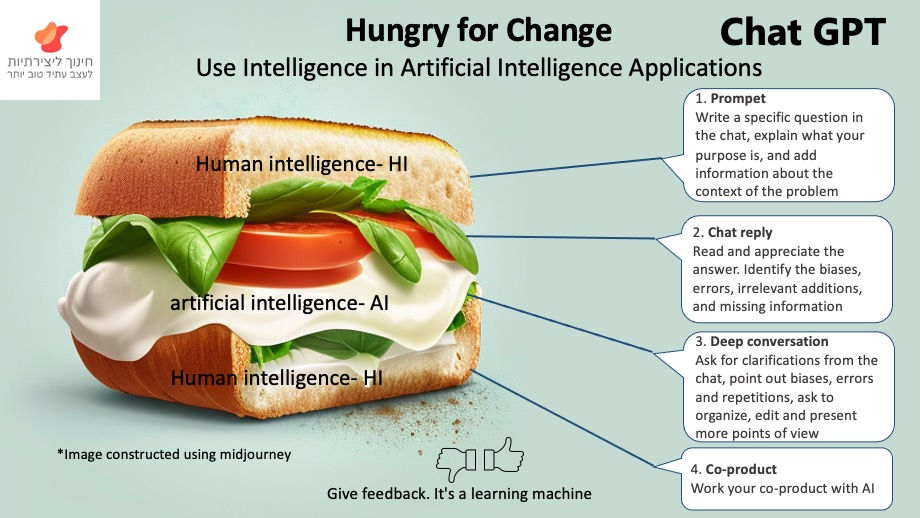Rethinking Puentedura's SAMR model in the AI Era
- Dr. Limor Leibovitz

- Aug 14, 2023
- 4 min read
Updated: Oct 2, 2023
Not long ago, a teacher asked me about making transformative shifts in teaching methods in this era of AI. That's when Dr. Ruben Puentedura's SAMR model came to my mind.
The SAMR framework outlines four pathways for incorporating tech into the classroom: Substitution, Augmentation, Modification, and Redefinition.
Check out this video for an exclusive chat with Dr. Ruben Puentedura himself.
I'll illustrate in straightforward terms how certain operations and digital applications functioned before the advent of AI, alongside examples of the same operations enhanced by AI tools.
For ease of understanding, let's focus on writing as a form of learning documentation. Writing aids both short-term and long-term memory and serves as a tool for learners to process information. Often, the written text becomes a tangible outcome of the learning process.
1. Substitution (SAMR)
Writing is a fundamental activity in our learning routines. It involves a blend of hand-eye coordination, visual information intake, and deeper cognitive processes like rephrasing, interpreting, and showcasing learned material in new ways. These actions enhance memory retention and deep learning. In the pre-digital age, we used notebooks to jot down key points, add illustrations, and sometimes even create mind maps with colored markers.
Digital Substitution in Modern Times: Classrooms today commonly use applications like OneNote, Google Docs, or Microsoft Word. While these platforms are increasingly incorporating AI, they can also function at a basic level where typing replaces handwriting. This is particularly useful for young students who are just getting acquainted with digital writing. Teachers often prefer digital submissions to avoid deciphering illegible handwriting. However, it's worth noting that digital writing eliminates the cognitive benefit of doodling. More on that can be found here.
2. Augmentation (SAMR)
Digital writing goes beyond mere substitution by offering features like spell-check, synonym suggestions, translations, easy editing, and cloud storage. Additional tools like Grammarly can further enhance writing, especially for non-native English speakers. These digital platforms foster skills in collaboration, application usage, and information literacy. They also offer multiple ways for students to engage with material, aligning with the Universal Design for Learning (UDL) principles. For instance, a student can record their answer if they struggle with typing, or opt to listen to instructions instead of reading them."
Feel free to click here for more information on the UDL approach.
3. Modification (SAMR)
While it might be premature to fully grasp the redefining impact of AI, it's worth exploring its role in writing and knowledge processing. AI applications can perform tasks like auto-summarization, sentence completion, and tone adjustment.
For instance, Otter.ai can record and summarize spoken content during a learning session. Although not designed for educational settings, similar functionalities exist in Microsoft Teams.
Moreover, the capabilities of ChatGPT 3.5, released in November 2022, include sentence completion, automatic editing, and more. These features assist in individual or group learning journeys.
The Changing Landscape
The phrase "Technology writes alongside us" encapsulates the transformation. Chatbots can assist in a myriad of tasks, from birthday greetings to career planning.
Recommended AI Tools:
Rubybot.ai: Ideal for lesson planning in Hebrew
Nolej.io: Generates a full course from a provided file or video
Tutorai.me: Creates courses from simple phrases or words
Caution: While chatbots are useful, they have limitations and biases. Always critically evaluate their output.
Safe Usage Guidelines for ChatGPT

While morning news often warns that advanced language models like these could replace human writers in fields such as journalism and speechwriting, there's no immediate cause for alarm. The reality is that skilled writers with valuable insights won't be easily replaced. Instead, they can leverage these AI tools to expedite research, assist in translation, and explore countless creative applications.
I argue that it's crucial for us to harness our creativity to reimagine essential learning processes. If we don't adapt quickly, we risk being replaced, regardless of our profession. Teachers concerned about AI affecting students' writing skills can use various tools to verify the originality of students' work.
For instance, using OpenAI's AI classifier can help, especially for English texts.
Teachers can also have students present their work, which encourages thorough preparation and understanding of the subject matter.
If we've already changed the writing landscape by introducing AI assistants that challenge the status quo, what's the next step in innovation?
4. Redefinition (SAMR)
I cautiously note that virtual guardians, which bring AI into our daily lives, pose a threat to traditional teaching roles. For example, Read&Write is a tool that aids in writing and daily tasks like reading text aloud and proofreading. This is a step toward redefining writing by introducing a virtual entity that acts like a real teacher. For those concerned about the shortage of 4,500 teachers in Israel, perhaps this offers a solution. In a previous post, I showcased a video of Kahan Academic's virtual teacher, Kahan Amigo, who guides students in online courses.
I've also discussed the development of social robots by Dr. Goren Gordon at Tel Aviv University, another avenue for enhancing classroom teaching, especially for younger students.
This challenge is only in its initial stages. Therefore, I invite you to join me in redefining the role of technology in classrooms. Choose a task relevant to your work or study, find an AI-based application for it, and reinvent that task. We'd love to hear about your experiences.
Register and tell us how you are Rethinking Puentedura's SAMR model in the AI Era.
Additional Information:
Register on the site for email notifications and to leave comments.
You can also book a lecture on ChatGPT technology and educational innovation.
Best wishes to all 21st-century educators!









Comments